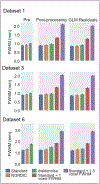Evaluating increases in sensitivity from NORDIC for diverse fMRI acquisition strategies
- PMID: 36804422
- PMCID: PMC10234612
- DOI: 10.1016/j.neuroimage.2023.119949
Evaluating increases in sensitivity from NORDIC for diverse fMRI acquisition strategies
Abstract
As the neuroimaging field moves towards detecting smaller effects at higher spatial resolutions, and faster sampling rates, there is increased attention given to the deleterious contribution of unstructured, thermal noise. Here, we critically evaluate the performance of a recently developed reconstruction method, termed NORDIC, for suppressing thermal noise using datasets acquired with various field strengths, voxel sizes, sampling rates, and task designs. Following minimal preprocessing, statistical activation (t-values) of NORDIC processed data was compared to the results obtained with alternative denoising methods. Additionally, we examined the consistency of the estimates of task responses at the single-voxel, single run level, using a finite impulse response (FIR) model. To examine the potential impact on effective image resolution, the overall smoothness of the data processed with different methods was estimated. Finally, to determine if NORDIC alters or removes temporal information important for modeling responses, we employed an exhaustive leave-p-out cross validation approach, using FIR task responses to predict held out timeseries, quantified using R2. After NORDIC, the t-values are increased, an improvement comparable to what could be achieved by 1.5 voxels smoothing, and task events are clearly visible and have less cross-run error. These advantages are achieved with smoothness estimates increasing by less than 4%, while 1.5 voxel smoothing is associated with increases of over 140%. Cross-validated R2s based on the FIR models show that NORDIC is not measurably distorting the temporal structure of the data under this approach and is the best predictor of non-denoised time courses. The results demonstrate that analyzing 1 run of data after NORDIC produces results equivalent to using 2 to 3 original runs and that NORDIC performs equally well across a diverse array of functional imaging protocols. Significance Statement: For functional neuroimaging, the increasing availability of higher field strengths and ever higher spatiotemporal resolutions has led to concomitant increase in concerns about the deleterious effects of thermal noise. Historically this noise source was suppressed using methods that reduce spatial precision such as image blurring or averaging over a large number of trials or sessions, which necessitates large data collection efforts. Here, we critically evaluate the performance of a recently developed reconstruction method, termed NORDIC, which suppresses thermal noise. Across datasets varying in field strength, voxel sizes, sampling rates, and task designs, NORDIC produces substantial gains in data quality. Both conventional t-statistics derived from general linear models and coefficients of determination for predicting unseen data are improved. These gains match or even exceed those associated with 1 voxel Full Width Half Max image smoothing, however, even such small amounts of smoothing are associated with a 52% reduction in estimates of spatial precision, whereas the measurable difference in spatial precision is less than 4% following NORDIC.
Copyright © 2023. Published by Elsevier Inc.
Figures








References
-
- Adhikari BM, Jahanshad N, Shukla D, Turner J, Grotegerd D, Dannlowski U, Kugel H, Engelen J, Dietsche B, Krug A, Kircher T, Fieremans E, Veraart J, Novikov DS, Boedhoe PSW, van der Werf YD, van den Heuvel OA, Ipser J, Uhlmann A, Stein DJ, Dickie E, Voineskos AN, Malhotra AK, Pizzagalli F, Calhoun VD, Waller L, Veer IM, Walter H, Buchanan RW, Glahn DC, Hong LE, Thompson PM, Kochunov P, 2019. A resting state fMRI analysis pipeline for pooling inference across diverse cohorts: an ENIGMA rs-fMRI protocol. Brain Imaging Behav. 13, 1453–1467. doi:10.1007/s11682-018-9941-x. - DOI - PMC - PubMed
-
- Blazejewska AI, Fischl B, Wald LL, Polimeni JR, 2019. Intracortical smoothing of small-voxel fMRI data can provide increased detection power without spatial resolution losses compared to conventional large-voxel fMRI data. Neuroimage 189, 601–614. doi:10.1016/j.neuroimage.2019.01.054. - DOI - PMC - PubMed
Publication types
MeSH terms
Grants and funding
LinkOut - more resources
Full Text Sources
Medical
Research Materials

